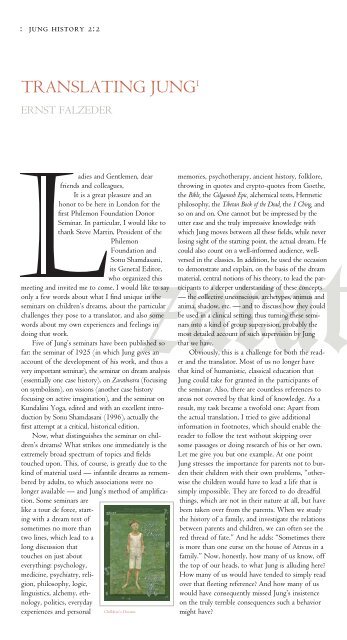a semi-annual publication of the philem n foundation - Philemon ...
a semi-annual publication of the philem n foundation - Philemon ...
a semi-annual publication of the philem n foundation - Philemon ...
Create successful ePaper yourself
Turn your PDF publications into a flip-book with our unique Google optimized e-Paper software.
: jung history 2:2<br />
TRANSLATING JUNG 1<br />
ERNST FALZEDER<br />
adies and Gentlemen, dear<br />
friends and colleagues,<br />
It is a great pleasure and an<br />
honor to be here in London for <strong>the</strong><br />
first <strong>Philemon</strong> Foundation Donor<br />
Seminar. In particular, I would like to<br />
thank Steve Martin, President <strong>of</strong> <strong>the</strong><br />
<strong>Philemon</strong><br />
Foundation and<br />
Sonu Shamdasani,<br />
its General Editor,<br />
who organized this<br />
meeting and invited me to come. I would like to say<br />
only a few words about what I find unique in <strong>the</strong><br />
<strong>semi</strong>nars on children’s dreams, about <strong>the</strong> particular<br />
challenges <strong>the</strong>y pose to a translator, and also some<br />
words about my own experiences and feelings in<br />
doing that work.<br />
Five <strong>of</strong> Jung’s <strong>semi</strong>nars have been published so<br />
far: <strong>the</strong> <strong>semi</strong>nar <strong>of</strong> 1925 (in which Jung gives an<br />
account <strong>of</strong> <strong>the</strong> development <strong>of</strong> his work, and thus a<br />
very important <strong>semi</strong>nar), <strong>the</strong> <strong>semi</strong>nar on dream analysis<br />
(essentially one case history), on Zarathustra (focusing<br />
on symbolism), on visions (ano<strong>the</strong>r case history<br />
focusing on active imagination), and <strong>the</strong> <strong>semi</strong>nar on<br />
Kundalini Yoga, edited and with an excellent introduction<br />
by Sonu Shamdasani (1996), actually <strong>the</strong><br />
first attempt at a critical, historical edition.<br />
Now, what distinguishes <strong>the</strong> <strong>semi</strong>nar on children’s<br />
dreams? What strikes one immediately is <strong>the</strong><br />
extremely broad spectrum <strong>of</strong> topics and fields<br />
touched upon. This, <strong>of</strong> course, is greatly due to <strong>the</strong><br />
kind <strong>of</strong> material used — infantile dreams as remembered<br />
by adults, to which associations were no<br />
longer available — and Jung’s method <strong>of</strong> amplification.<br />
Some <strong>semi</strong>nars are<br />
like a tour de force, starting<br />
with a dream text <strong>of</strong><br />
sometimes no more than<br />
two lines, which lead to a<br />
long discussion that<br />
touches on just about<br />
everything: psychology,<br />
medicine, psychiatry, religion,<br />
philosophy, logic,<br />
linguistics, alchemy, ethnology,<br />
politics, everyday<br />
experiences and personal Chilldren’s Dreams<br />
memories, psycho<strong>the</strong>rapy, ancient history, folklore,<br />
throwing in quotes and crypto-quotes from Goe<strong>the</strong>,<br />
<strong>the</strong> Bible, <strong>the</strong> Gilgamesh Epic, alchemical texts, Hermetic<br />
philosophy, <strong>the</strong> Tibetan Book <strong>of</strong> <strong>the</strong> Dead, <strong>the</strong> I Ching, and<br />
so on and on. One cannot but be impressed by <strong>the</strong><br />
utter ease and <strong>the</strong> truly impressive knowledge with<br />
which Jung moves between all <strong>the</strong>se fields, while never<br />
losing sight <strong>of</strong> <strong>the</strong> starting point, <strong>the</strong> actual dream. He<br />
could also count on a well-informed audience, wellversed<br />
in <strong>the</strong> classics. In addition, he used <strong>the</strong> occasion<br />
to demonstrate and explain, on <strong>the</strong> basis <strong>of</strong> <strong>the</strong> dream<br />
material, central notions <strong>of</strong> his <strong>the</strong>ory, to lead <strong>the</strong> participants<br />
to a deeper understanding <strong>of</strong> <strong>the</strong>se concepts<br />
— <strong>the</strong> collective unconscious, archetypes, animus and<br />
anima, shadow, etc. — and to discuss how <strong>the</strong>y could<br />
be used in a clinical setting, thus turning <strong>the</strong>se <strong>semi</strong>nars<br />
into a kind <strong>of</strong> group supervision, probably <strong>the</strong><br />
most detailed account <strong>of</strong> such supervision by Jung<br />
that we have.<br />
Obviously, this is a challenge for both <strong>the</strong> reader<br />
and <strong>the</strong> translator. Most <strong>of</strong> us no longer have<br />
that kind <strong>of</strong> humanistic, classical education that<br />
Jung could take for granted in <strong>the</strong> participants <strong>of</strong><br />
<strong>the</strong> <strong>semi</strong>nar. Also, <strong>the</strong>re are countless references to<br />
areas not covered by that kind <strong>of</strong> knowledge. As a<br />
result, my task became a tw<strong>of</strong>old one: Apart from<br />
<strong>the</strong> actual translation, I tried to give additional<br />
information in footnotes, which should enable <strong>the</strong><br />
reader to follow <strong>the</strong> text without skipping over<br />
some passages or doing research <strong>of</strong> his or her own.<br />
Let me give you but one example. At one point<br />
Jung stresses <strong>the</strong> importance for parents not to burden<br />
<strong>the</strong>ir children with <strong>the</strong>ir own problems, “o<strong>the</strong>rwise<br />
<strong>the</strong> children would have to lead a life that is<br />
simply impossible. They are forced to do dreadful<br />
things, which are not in <strong>the</strong>ir nature at all, but have<br />
been taken over from <strong>the</strong> parents. When we study<br />
<strong>the</strong> history <strong>of</strong> a family, and investigate <strong>the</strong> relations<br />
between parents and children, we can <strong>of</strong>ten see <strong>the</strong><br />
red thread <strong>of</strong> fate.” And he adds: “Sometimes <strong>the</strong>re<br />
is more than one curse on <strong>the</strong> house <strong>of</strong> Atreus in a<br />
family.” Now, honestly, how many <strong>of</strong> us know, <strong>of</strong>f<br />
<strong>the</strong> top <strong>of</strong> our heads, to what Jung is alluding here?<br />
How many <strong>of</strong> us would have tended to simply read<br />
over that fleeting reference? And how many <strong>of</strong> us<br />
would have consequently missed Jung’s insistence<br />
on <strong>the</strong> truly terrible consequences such a behavior<br />
might have?


